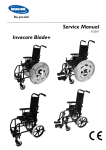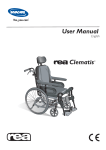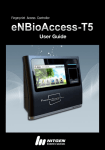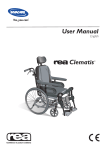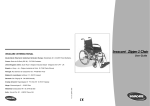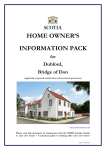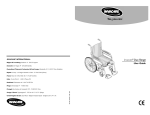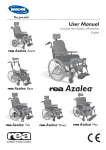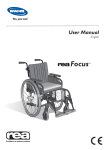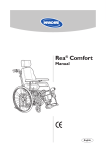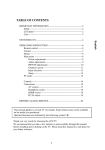Download User Manual Invacare Blade+
Transcript
User Manual English Invacare Blade+ ©Invacare Every effort has been made to ensure that the contents of this publication are updated at the time of printing. As part of the ongoing improvement of the products, Invacare reserves the right to modify existing models at any time. Any use of this publication, or parts thereof, as well as any reproduction of images, must have the written consent of Invacare. 2 Invacare Blade+ Contents 1. General 4 1.1 INTRODUCTION 1.2 SYMBOLS 4 1.3 COPYRIGHT PROTECTION 1.4 WARRANTY 1.5 LIMITATION OF LIABILITY 1.6 CUSTOMER SERVICE 1.7 ACCIDENTS/NEAR ACCIDENT 1.8 INTENDED USE 1.9 SERVICE LIFE 2. Safety 3.1 DIMENSIONS AND WEIGHT 3.2 COLOURS 3.3 EQUIPMENT 3.4 CONFORMANCE TABLE 3.5 IDENTIFICATION LABEL 4 4 4 4 5 5 5 21 21 22 22 23 6. Using the wheelchair 6.1 MOVE TO/FROM THE WHEELCHAIR 6.2 STRETCHING AND LEANING 6.3 PROPELLING UP A SLOPE 6.4 PROPELLING DOWN A SLOPE 6.5 CLIMBING A KERB 6.6 KERBS – ALTERNATIVE METHOD 6.7 ESCALATORS AND STAIRS 6 2.1 LIFTING THE WHEELCHAIR 2.2 DAILY PERFORMANCE CHECK 2.3 SPECIFIC RISKS 2.4 WHEELCHAIR OVERVIEW 3. Technical data 4 5.9.1 Rear anti-tippers 5.9.2 Tipping levers 5.9.3 Pelvic belt 5.9.4 Recliner backrest 5.9.5 Hub brakes 6 6 6 7 7. Transport 8 8 9 9 10 11 24 24 24 24 25 25 26 26 27 7.1 TRANSPORTING WHEELCHAIRS WITH USERS IN VEHICLES 27 7.2 RESTRAINT METHODS 29 Swing-away foot rests 29 Outrigged castors 29 8. Maintenance 8.1 MAINTENANCE SCHEDULE 8.2 CLEANING 30 30 31 4. Set-up and installation12 4.1 DELIVERY CHECK 4.2 ASSEMBLY 4.2.1 Backrest 4.2.2 Armrests 4.2.3 Rear wheels 4.2.3 Swing-away footrests 12 12 12 12 12 13 9. After use 32 5. Components and their adjustments 14 5.1 BACKREST 14 5.1.1 Backrest extension (option) 14 5.2 SEAT 15 5.2.1 Seat cushion 15 5.3 ARMRESTS 16 5.4 FOOTRESTS 17 5.4.1 Swing-away footrest supports 17 5.4.2 Footrest supports for outrigged chassis 17 5.5 REAR WHEELS 18 5.5.1 Tyre pressure 18 5.6 AXLES 19 5.7 BRAKES 19 5.7.1 User brake 19 5.8 CASTORS 20 5.9 ACCESSORIES 21 Invacare Blade+ 3 1. General 1.1 INTRODUCTION 1.4 WARRANTY Thank you for choosing a Blade + manual wheelchairwe are certain that you will be delighted with it. Just to make doubly sure you really gain the full benefits from your remarkable new INVACARE wheelchair and to ensure many years of trouble free performance, this manual gives you essential information concerning Safety, Handling and Operation, together with some helpful tips. Please read it carefully before trying out your new Blade +, so that you may truly enjoy your new independence. Contractual guarantee This is to certify that your Blade + wheelchair is warranted by Invacare, for a period of 5 years for the frame and crossbars and 24 months for all other parts. This warranty is subject to the following conditions: We recommend to have your wheelchair inspected and serviced by an authorised INVACARE dealer at least once a year. It is in your best interests, not only to ensure your personal safety, but also the continued high performance and long service life of your wheelchair. Whenever you need special advice and assistance, or if there is any problem with your wheelchair, do not hesitate to contact the local INVACARE dealer. He is just a phone call away and has all the equipment and knowhow required to provide you with expert professional service. 1.2 SYMBOLS This symbol means warning and is used in the user manual for important information to prevent injuries and material damage 1.3 COPYRIGHT PROTECTION The information set out in this manual may be modified without prior notice. This manual contains copyright information. All rights are reserved. No part of this document may be photocopied or reproduced without prior written agreement from INVACARE or its appointed representative. 4 1. Only Invacare wheelchairs purchased at full price are warranted against defective workmanship and materials. 2. If a defect or fault is discovered the supplier from whom the appliance was purchased/obtained should be notified immediately. 3. The manufacturer will not accept responsibility for damage caused by misuse or the nonobservance of the intructions set out in the User Manual. 4. During the period of the warranty, any parts that have become defective due to faulty workmanship or materials, will be renewed or repaired free of charge by the Invacare supplier. 5. The warranty will be forfeited should any unauthorised alteration be made to the equipment. 6. The purchaser’s statutory rights under the Consumer Protection Act are not affected. 1.5 LIMITATION OF LIABILITY This warranty does not extend to the consequential costs resulting from fault clearance, in particular freight and travel costs, loss of earnings, expenses, etc. Invacare shall not be liable for: - natural wear and tear - inappropriate or incorrect use - defective assembly or setting-up by the purchaser or third parties - defective or negelectful treatment - use of unsuitable spares 1.6 CUSTOMER SERVICE For contact details please refer to the last page of this publication where you will find addresses to the European sales companies. Invacare Blade+ 1.7 ACCIDENTS/NEAR ACCIDENTS Please inform your Invacare office immediately of any accidents or near-accidents that have been caused by this wheelchair and that have led to, or could have led to, personal injury. The relevant authority must also be contacted and reported to. 1.8 INTENDED USE INVACARE BLADE + Indoor and outdoor configurable wheelchair offered with various options compliant with EN 12184:1999 Section 5 Class B. 1.9 SERVICE LIFE INVACARE BLADE + We assume that our wheelchairs will be in use daily. For this reason the whole equipment is subject to an almost continuous stress and consequently, natural wear and tear. Taking this into consideration and provided that the wheelchair is maintained properly, the lifetime of the Invacare Blade+ is approximately 5 years. If the wheelchair is used less frequently, e.g. if you use it inside your apartment only, and if it is maintained perfectly, the service life may increase accordingly. The Blade Plus manual wheelchair has been designed to provide mobility and comfort for persons with impaired mobility. The wheelchair has been designed to be used either/or by a seated user/carer/attendant on both indoor and outdoor environments. The wheelchair has, in its standard format, been designed to accomodate users who weigh up to a maximum of 90 kg, have all limbs intact and have sufficient upper body strenght to maintain a safe position within the wheelchair without the addition of supporting aids. Adaptions from standard wheelchair format are available to accomodate users who do not meet the above criteria, but these will only be considered after a suitable assessment of the risk has been carried out by a qualified person. For example: A user with either a full or a partial amputation or other condition which affects the centre of gravity will need to have a stability evaluation to minimize the risk of inadvertant tipping. The wheelchair should only be used in accordance with the safety advice given within this user guide. Failure to follow the recommended advice could lead to personal injury. No claims are made that the product will medically inprove the circumstances or condition of the user. Invacare Blade+ 5 2. Safety 2.1 LIFTING THE WHEELCHAIR 2.3 SPECIFIC RISKS Below you will find a number of points affecting your personal safety. Read them carefully! Invacare is only responsible for product changes carried out by trained personnel We reserve the right to make any changes to equipment and specifications without prior notice. Failure to comply with instructions given may result in personal injury and/or product damage. • • • • • Always lift the wheelchair by grabbing the frame at the points shown in the picture. Never lift the wheelchair by the removable armrests or the footrests. Ensure that the backrest and push handles are securely in place. Also read the chapter Safety instructions/Propelling techniques. • • • • 2.2 DAILY PERFORMANCE CHECK Check that the following parts are correctly fitted on the wheelchair: • Wheels • Backrest • Anti-tip device • Push handles • Footrests • Brakes • Armrests • Lap belt • Seat/back upholstery 6 • • • Check each of the following before using the wheelchair: – that all parts are attached securely to the frame – that all wheels, knobs, screws and nuts are properly tightened – that all brakes and anti-tip devices function correctly Never lift the wheelchair by the detachable armrests, footrests, backbrace or by the adjustable push handles. Always apply the brake before getting into or out of the chair. Never stand on the footplates when getting into or out of the chair, because of the risk of tipping. Changing the seat angle gives an increased risk of tipping over. The handrims may become hot due to friction, which may cause injury to your hands. Use the anti-tip device Remember that the effectiveness of the careroperated brake is reduced in wet and slippery conditions, as well as when on a slope. Be careful to ensure that the rearwheels are securely attached. Surfaces of the wheelchair like frame parts or upholstery can, after long exposure to the sun, reach temperatures over 41°C which may cause discomfort or burns. When mounting accessories etc. be careful not to trap your fingers. There is always an increased risk of trapping parts of your body when tilting the wheelchair’s back and seat. Invacare Blade+ 2.4 WHEELCHAIR OVERVIEW Transit version: 1. Transit wheel 2. Castor 3. Footrest 4. Outrigged frame 5. Seat 6. Armrest 7. Backrest 8. Push handles 9. Backrest folding mechanism 7 8 6 5 9 1 4 3 2 10 Self propel version: 1. Rear wheel 2. Handrim 3. Spoke guard 4. Castor 5. Swing-away fottrests 6. Brake 7. Seat 8. Armrest 9. Backrest 10. Push handles 11. Backrest folding mechanism 9 7 8 11 1 6 2 5 3 4 Invacare Blade+ 7 3. Technical data 3.1 DIMENSIONS AND WEIGHT Seat width Legrest length Weight Total width Maximum user weight Seat width inches Seat width cm Seat depth inches Seat depth cm Seat to Ground height inches Seat to Ground height cm Backrest height inches Backrest height cm Armrest height Adjustable inches Armrest height Adjustable cm Legrest length Total width Swingaway inches Total width Swingaway cm Total width Outrigged inches Total width Outrigged cm Total height Total length Weight Max user. weight 8 Seat height Seat depth 10" 25.5cm 9" 23cm 18" 45.7cm 16½" 42cm 3½" 9cm 15 - 28cm 17" 43cm 18½" 47cm 62 - 94cm 89 - 94cm 13.5 - 15kg 90kg Armrest height Backrest height Total length Total height Folded width Maximum incline 11" 28cm 10" 25.5cm 12" 30.5cm 11" 28cm 13" 33cm 12" 30.5cm 14" 33.5cm 13" 33cm 15" 38cm 14" 35.5cm 4½ 11.5cm 5½ 14cm 6½ 16.5cm 7½ 19cm 8½ 21.5cm 18" 46cm 19½" 49.5cm 19" 48cm 20½" 52cm 20" 51cm 21½" 54cm 21" 53cm 22½" 57cm 22" 56cm 23½" 60cm 15" 38cm Invacare Blade+ 3.2 UPHOLSTERY AND FRAME COLOURS Upholstery type and Backrest cover Black Canvas Frame colours Black, metallic red, metallic blue, metallic purple 3.3 EQUIPMENT AND ACCESSORIES Invacare offers the Blade Plus wheelchair in various defined optional types. Please refer to the Invacare Ltd prescription forms or contact the Invacare cumstomer service for further information. Backrest Folding Fixed Vertical back with adjustable push handles 0-30° reclining back Seat cushions Standard 5 cm Flotech lite Legrests Swing-away Outrigged Height, backward, forward and rotational adjustment footplates Multi-adjustable Rea Adapt style footplate Armrests Detachable with adjustable height Castors 12,5*2,5 cm solid 12,5*4,5 solid Rear wheels 12,5, 20, 22’’ solid or pneumatic Brake Push to lock brakes Extended push to lock brakes Attendant drumbrake Others Spoke guard Anti-tip device Table Tray fixation Pelvic belt Sideguard Tipping lever Capstan handrim Invacare Blade+ 9 3.4 CONFORMANCE TABLE WIDTH/DEPTH WIDTH HEIGHT 10 10''/25,5 cm 11''/28 cm 12''/30,5 cm 13''/33 cm 14''/35,5 cm 15''/38 cm 9''/23 cm Y Y Y Y N N 10''/25,5 cm Y Y Y Y N N 11''/28 cm Y Y Y Y N N 12''/30,5 cm Y Y Y Y Y Y 13''/33 cm N N Y Y Y Y 14''/35,5 cm N N Y Y Y Y 15''/38 cm N N Y Y Y Y Invacare Blade+ 3.5 IDENTIFICATION LABEL Maximum incline Manufacturing date Model INVACARE International SARL Serial No. Max. user weight Unladen weight Total weight Location of the identification/serial label on the wheelchair Invacare Blade+ 11 4. Set-up and installation 4.2.2 Armrests 4.1 DELIVERY CHECK Any transport damage must be reported immediately to the transport company. Remember to keep the packaging until the transport company has checked the goods and a settlement has been reached. 4.2 ASSEMBLY When you receive your wheelchair, you must fit the backrest, armrests and legrests onto the chair. The assembly is simple and does not require any tools. 4.2.1 Backrest The armrests can be removed for easier storage and allow sideways transfer from the chair. They can also be adjusted in height to suit the individuals preference, see page 16. 4.2.3 Rear wheels A B When delivered, you might need to put the backrest in place. Raise the top part of the backrest to an upright position and make sure that the locking mechanisms (A) are secure. Now check that the backrest is secured firmly in position! A Attach the rear wheels by pressing button (A) in the centre of the hub whilst simultaneously sliding the axle into the rear wheel position attachment of the positioning plate. It is very important that you check that the locking pin (B) has actually locked the wheel into position when the centre button has been released. Take hold of the wheels and try to detach them. This should NOT be possible. 12 Invacare Blade+ 4.2.3 Swing-away footrests B A Place the footrests on the holders (A) on the outside of the frame. Turn inwards and activate the spring mechanism (B). Invacare Blade+ 13 5. Components and their adjustments 5.1 BACKREST 5.1.1 Backrest extension (option) A B The backrest can be folded at the middle by means of a locking mechanism and can be operated by either the user or an attendant. - Use: To fold the backrest, pull both black plastic locking levers (A) downwards and fold the top part of the backrest to the back and then down. Carry out these operations in the reverse order to return the backrest to its normal position, making sure that the locking mechanisms (A) are secure. 14 The backrest extension has two uprights (B) and a backrest extension upholstery. The locating pegs should only be fitted to the push handles of the backrest by a qualified technician. When refitting, make sure that it is firmly fixed onto the locations fitted to the backrest tubes. Raise the head rest assembly to remove it from the tubes of the recliner backrest. Invacare Blade+ 5.2 SEAT 5.2.1 Seat cushion A B Your seat upholstery is screwed onto the seat tubes of the folding cross brace. Seat cushion The seat cushion is placed on the upholstery and must be removed when folding the chair. Adjustment: This model requires no adjustment. Just check regularly that the screws (A) are tight. If the washers (B) are loose, these screws should be tightened. If the problem continues, contact your INVACARE retailer and ask him to change the mounting for safety reasons. Invacare Blade+ 15 5.3 ARMRESTS A B C The armrests can be removed for easier storage and allow sideways transfer from the chair. They can also be adjusted in height to suit the individuals preference. To adjust the height, the armrest lever (A) is lifted up which allows the armrest to slide up and down, within the armrest block (B). The armrest has an adjustment collar (C) that works both as a stop for the armrest and as a memory for the height used. It can be adjusted by loosening the screw. When the desired height has been achieved, lower the armrest lever and push down/pull up the armrest until the armrest drops into place. To make sure that this has happened try to pull up/ push down the armrest, if it is located the armrest should be “locked in”, and the lever should be in its down position. 16 Invacare Blade+ 5.4 FOOTRESTS 5.4.2 Footrest supports for outrigged chassis 5.4.1 Swing-away footrest supports A A The footrest supports can be swung away to the outside/rear of the chair to free the front of the wheelchair making it easier for the user to transfer to another seat. They can also be removed. Use: To swing the support to the outside, press the release mechanism lever. Rotate the support carefully to the outside of the wheelchair. To return the support, repeat the operations in the reverse order. Check that the release mechanism has automatically locked. Independent footplates for footrest supports The footplate assemblies comprise of an adjustment tube and footplate and are intended solely as a foot support when you are sitting in the wheelchair and should not be used for standing. Each footplate assembly can be adjusted in height. The footplates can be pivoted to an upright position to aid front transfers. Adjusting the footrests on the supports: Release the nut, position the footplate assembly at the required height in the footrest support tube, tighten the nut to secure. To remove the support, swing the assembly away from the chair, release the spring mechanism and lift the support away from the chair. Adjustment: Loosen the screws (A), adjust to the required height and re-tighten screws. NB: The footrest supports are fitted in pairs to the wheelchair. When adjusting or removing, remember that there is one support for the right hand side and another for the left hand side. Invacare Blade+ 17 5.5 REAR WHEELS The rear wheels are positioned on rear wheel mounting blocks which determine the rearward stability. This position should only be adjusted by a qualified technician on the advise of a qualified advisor. The rear wheels have a diameter of either 12,5’’, 20’’, or 22’’. They are equipped with spokes and handrims (not 12,5’’). They can have pneumatic tyres or solid tyres and can be connected to the side frame by means of a fixed axle or a quick release axle. The risk of tipping increases when the rear wheels moved forward. Compensate by mounting an anti-tip device on the wheelchair. Do not remove the handrims! They provide stability to the wheel and the entire wheelchair. 5.5.1 Tyre pressure The pressure is shown on the tyre and must never be exceeded. Remember that the tyre pressure on both wheels should be the same to ensure perfect steering. In case of a puncture, the tyre has to be removed from the rim. Press the valve to let all the remaining air out of the inner tube. Pull the tyre off the rim. Repair or replace the inner tube. Put the tyre back on the rim. Inflate the tyre to the required pressure. - NB: It may be necessary to use one or two tyre removal tools (not supplied). 18 Invacare Blade+ 5.6 AXLES 5.7 BRAKES 5.7.1 User brake The axles link the back wheels to the chassis. They are fixed or quick releasing. Quick release wheels Removal: Push on the quick release button head with your finger and pull the wheel towards the outside of the chair. For illustration see page 12. Assembly: Push on the quick release button head with your finger and locate axle though the axle bush, making sure that the axles are secured (no axial movement). Fixed wheels No adjusment is required, however, check on a weekly basis that the axle / nut are secure. The manual brakes are used to immobilise the wheelchair in a stationary position. They are not intended for slowing down and should not be used when the wheelchair is moving. They should be applied together. Use: The brakes are operated by moving the brake handle (A) towards the front of the wheelchair. When the brakes are applied, the wheelchair should resist movement. Adjustment: It may be necessary to adjust the brakes after repairing a puncture or because of wear on the pneumatic or solid tyre. Slacken clamp screws and adjust the brake assembly to achieve adequate braking. Tighten the clamp screws firmly after adjustment. NB: The brakes are fitted in pairs to the wheelchair. When adjusting or removing, remember that there is one brake for the right hand side and another for the left hand side. Brake extension The brakes may be equipped with a handle extension to assist attendants/user who have insufficient strength or difficulty in reaching the standard brake handles. Invacare Blade+ 19 5.8 CASTORS The front wheels have a diameter of 125mm. For the different types of castors available, please refer to the prescription form. No adjustment is necessary for the castors. Forks The fork connects the chassis and the wheel. Adjustment: The forks do not require adjustment. Check that the fork rotates freely. 20 Invacare Blade+ 5.9 ACCESSORIES 5.9.2 Tipping levers 5.9.1 Rear anti-tippers B B A A B A The anti-tippers help prevent you from tipping over. Invacare recommend the use of anti-tippers at all times. Use: The anti-tippers fit into the rear tubes of the side frames (A). Fit the anti-tippers into the side frame rear tube, until the button springs are positioned in the holes of the rear tube (B). Carry out these operations in the reverse order to remove. You can leave the anti-tip castors on the wheelchair even if you do not wish to use them. Just depress the button spring and rotate the entire anti-tipper unit a half turn (180°). DO NOT twist or turn the Anti-Tipper when withdrawing it from the frame. Invacare Blade+ The tipping lever can only be used by an attendant and it is designed to assist tipping the chair rearwards when obstacles are encountered, such as pathway or kerbs. The tipping lever tubes are fixed into the rear tubes of both side frames (A). Fit the tipping lever into the side frame rear tube, until the button springs (B) are positioned in the holes of the rear tube. - Use: The attendant, whilst pulling the wheelchair push handles must press on the tipping levers with either foot, in order to raise the front of the wheelchair to the required height. 21 5.9.3 Pelvic belt 5.9.4 Recliner backrest a b c 1. The pelvic belt is used to prevent the risk of falling or sliding out of the chair and for providing the user with a good posture. 2. The pelvic belt is mounted on the backrest brackets. Thread the belt through the mounting on the chair and then through the two plastic buckles. It is important that both buckles are used. There is a danger the belt might slip if the belt is threaded through only one. Gas Spring Type CAUTION: It is recommended that this operation be performed only by the attendant. Always make sure that the backrest is locked in place to ensure perfect safety for the user. Keep fingers away from moving parts (levers, cylinders, mechanisms, etc.) to prevent injuries! 1. Grip the push handles with both handles 2. Pull the triggers and raise or lower the back to the desired position, supporting the backrest by means of the push handles at all times during adjustment. Release triggers 3. Adjustment Ensure that the user is sitting fully back in the seat and that the pelvis is as upright and symmetrical as possible - not forward on one side or tilted back. Position the lap belt so that the hip bones can be felt above the belt. Adjust the length using the buckles so that there is just sufficient room for your hand to slide between your body and the belt. It is recommended that the clasp is kept in a central position, i.e. make adjustments to each side. These adjustments should be checked and possibly changed each time the belt is used. 4. If the belt has come loose at the metallic clasp it should be threaded according to the pictures a-c. Please make sure that the belt cannot slide. 22 Invacare Blade+ 5.9.5 Hub brakes Torque 3-4 Nm Loctite 243 Torque 6 Nm Torque 40-45 Nm Besides the functions provided by manual brakes, the optional hub brakes provide slow down (for example, on a slope) and improve safety because they are still efficient when you have a flat tyre! To slow down gradually pull the lever upwards. To lock the brake in parking position, with the lever tightened, push the lock to engage it in the notches of the brake handle;then pull the lock up to unlock. To adjust braking:turn the screw counterclockwise to increase braking force and turn clockwise to reduce it. Always mount the hub brake attachment in the rear backwards position. The specific adjustments of hub brakes must always be performed by your Dealer. Always operate the two brakes simultaneously and do not take slopes exceeding 5% to ensure perfect control of the wheelchair steering! Invacare Blade+ 23 6. Using the wheelchair We recommend that you have the chair tested by the qualified person who has prescribed the wheelchair, after he or she has made the adjustments that you request, taking your build and needs into account. We hope that you have also received help in learning how best to use the wheelchair. Start by practising carefully until you are familiar with the wheelchair’s possibilities and limitations. 6.1 MOVE TO/FROM THE WHEELCHAIR Propel the wheelchair as near as possible to the seat that you want to move to. Apply the brake. Remove the armrests and detach the legrests or swing them outwards. Do not support yourself on the footplates as this may cause the chair to tip forwards. 6.2 STRETCHING AND LEANING 6.3 PROPELLING UP A SLOPE Many experienced users can propel themselves up a slope. In order not to lose control of the steering and to avoid tipping backwards, you should always lean forwards whilst propelling up a slope. Propel the wheelchair forwards using short, quick strokes applied to the hand rims, in order to maintain speed and steering control. Generally, help is needed on steep slopes. If you have to stop on a slope, it is particularly important to ensure that you do not make any sudden or unexpected backward movements when you start moving the wheelchair forwards again. As the wheelchair is already leaning backwards, such a movement may cause the wheelchair to tip backwards. The maximum gradient of slopes that can be attempted is varied between 3° and 13,5° depending on the user weight, physical ability and the adjustments of the wheelchairs. Always use anti-tippers. Propel the wheelchair as near as possible. When stretching and bending, do always have full contact between the backrest and the back otherwise the wheelchair may tip over. Stretching behind the back is not recommended. 24 Invacare Blade+ 6.4 PROPELLING DOWN A SLOPE 6.5 CLIMBING A KERB We recommend that you obtain the help of one or more assistants when going down steep and wet slopes. This method is for when the assistant is always behind the wheelchair and it creates the greatest safety for the user. The following advice is for the assistant: Illustration 1) Adjust the anti-tip devices upwards. Ensure that the user’s feet rest securely on the footrests and cannot slide off. Then tilt the wheelchair backwards and push it forwards against the kerb. First check the slope to see if there are any particular hazards, potholes, slippery sections, etc. Never use the user-operated brake to slow down. When you apply the brake on a downward slope, the wheels lock and the wheelchair can suddenly pull to one side, tip sideways or stop immediately, which may cause you to be thrown out of the chair. Always control the speed with the hand rims. Remember that the hand rims may become hot due to friction, and this may cause injury to your hands. Try to propel down the slope in a straight line as much as possible. Illustration 2) Lower the frontal part of the wheelchair onto the pavement and place yourself as close to the chair as possible, before you lift up the whole wheelchair. Illustration 3) Lean forward and lift/roll the wheelchair over the pavement edge. Illustration 4) Lower the wheelchair onto the pavement so that the weight is divided on all four wheels. Ensure that the wheelchair does not roll backwards. To dismount kerb, follow the procedure above, but in reverse order (step 4, 3, 2 and then 1) to move off a kerb. Invacare Blade+ 25 6.6 KERBS – ALTERNATIVE METHOD 6.7 ESCALATORS AND STAIRS This method is generally used by experienced assistants who are stronger than average. It can also be used when the kerb or step is low and only constitutes a minimal obstacle. Do not use escalators when you are in the wheelchair. Find out whether there is a lift nearby. The assistant steps backwards onto the pavement and pulls the wheelchair up onto the pavement. It is important for the assistant to use his or her body correctly to prevent injury. Tip the wheelchair backwards and roll the chair over the kerb onto the pavement. Take particular care if the kerb is wet or slippery. 26 We recommend that you receive help from two assistants to get up and down stairs. One assistant walks in front of the chair holding the frame of the wheelchair, whilst the other assistant walks behind the chair, holding the push handles. Check that the push handles/push bar are securely fixed in place before you start. Fold the anti-tip devices upwards. Balance the wheelchair on the rear wheels until the balance point is found. The wheelchair is then rolled down the stairs, step by step, by letting the rear wheels roll over the edge of each step. Assistants must not lift by gripping the removable armrests or legrests. They must remember to lift the chair at the correct points, to use their legs and to keep their backs as straight as possible. Invacare Blade+ 7. Transport Invacare has continuously worked to improve the safety in all our products for the users in different everyday situations. This has, among other things, meant that Invacare since the mid 1990’s has let accredited research institutes crash test several of the manual wheelchair models. We would like to inform you about the transport of wheelchairs with seated users in vehicles that are especially adapted for this purpose. First and foremost, we would like to point out that it is always the safest option for the user to be transported in the vehicle’s regular seat fastened with the regular safety belt. Invacare cannot recommend transport seated in the wheelchair. But, we are aware that there are users and situations that require vehicle transport seated in the wheelchair. In these cases, the safety rules in the following pages must be followed in order to reduce the risk of injury in the case of an accident. The wheelchair has been tested according to the specifications in ISO 7176-19 “Wheeled mobility devices for use as seats in motor vehicles”.This means that it has been through and met the requirements in a standard test of one possible situation – full frontal collision in 48 km/h with a deceleration of 20 g and a 75 kg test dummy. The test standard ISO 7176-19 is developed by authorities and specialists and it states a minimum demand on wheelchairs regarding transport in vehicles. This standard is updated regularly as knowledge and experience increases. In reality, an incident will be different from the circumstances in a test laboratory environment. For example will speed, impact angle, configuration of the chair, user weight and deceleration probably vary. Invacare declines any responsibility for the outcome of a possible accident where our products are involved. We have chosen to test what we believe to be a frequently occurring configuration with common adjustments made. Configurations and accessories that are unsuitable for seated transport in a vehicle are mentioned later on in this chapter. 7.1 TRANSPORTING WHEELCHAIRS WITH USERS IN VEHICLES 1.The wheelchair and user should be transported forward-facing in the direction of travel. All auxiliary equipment such as tables, trunk support, abduction cushion etc should be removed and stored safely so that they do not injure anyone during any kind of accident. 2. The wheelchair should be secured in the vehicle with a 4-point restraint system. The user should wear a 3-point safety belt secured in the vehicle. Both the 4-point restraint system and the 3-point safety belt should be approved according to ISO10542-2. Note: Non-contractual picure, for information only 3.The tie-down points on the wheelchair where the restraint system straps should be placed are marked with this symbol. Invacare Blade+ 27 4. In order to be used as a seat during transport in a vehicle, the wheelchair must be equipped with a pelvic belt. 7. The backrest must be adjusted to an upright position. Incorrect placement of safety belt 5. The vehicle's safety belt should fit as tightly across the user's body as possible without discomfort. The upper part of the safety belt should fit over the user's shoulder as illustrated. No part of the safety belt must be twisted. 8. The 3-point safety belt must not be held away from the user's body by parts of the wheelchair such as armrests or wheels etc. A 6. The pelvic part of the 3-point safety belt must be worn low across the pelvis so that the angle of the pelvic belt is within the preferred zone (A) of 30° to 75° to the horizontal. A steeper angle is preferred, but never exceeding 75°. 28 Invacare Blade+ 7.2 RESTRAINT METHODS Frontal restraints with straps 1. Connect the frontal straps around the castor attachment. See pictures for exact placement. 2. Release brakes and tension front straps by pulling the wheelchair backwards. Re-apply wheelchair brakes. Rear restraints 1. Attach the snap hooks on the rear straps to the vertical rear tube by the rear wheel attachment. 2. Tighten the straps. For transit versions of the wheelchair the attachment points are the same. Swing-away foot rests Outrigged castors Invacare Blade+ 29 8. Maintenance 1. General The wheelchair unfolds and folds easily The wheelchair moves in a straight line (no resistance or drag) 2. Manual brakes/Attendant Hub Brakes The brakes do not touch the tyres when moving The brakes are easy to operate The articulations are not worn and do not show signs of play 3. Cross bars Examine them to check that they are not worn or bent 4. Clothing protectors / armrest upholstery Check that all fixings are in position and tightened 5. Armrests Firmly attached but easy to remove 6. Arm pads Check that the padding is in good condition 7. Seat and backrest upholstery Check that it is in good condition 8. Rear wheels Wheel nut and sealed bearings correctly tightened No excessive lateral movement or binding when they are lifted from the ground and turned, quick release axles correctly locked 9. Anti Tippers/Levers Check they are secure and in good condition 10. Handrims Check for rough patches 11. Spokes Inspect the spokes in case any are bent, broken or slack 12. Castors Check the axle to ensure that it is correctly tightened, by turning the castor the castor should stop gradually 13. Fork / Fork tube Check that all the fittings are in place 14. Pneumatic and solid tyres If the wheelchair has pneumatic tyres, check that they are correctly inflated (the pressure is shown on the sidewall) If the wheelchair has solid tyres, check the running surface 15. Any Additional Accessories Check they are secure and in good condition 30 X X X X X X X X 6 monthly inspection Monthly inspection/adjustment On delivery Weekly inspection/adjustment 8.1 MAINTENANCE SCHEDULE X X X X X X X X X X X X X X X X X X X X X X X X X X X X X X X X X X X X X X X X X X X X X X Invacare Blade+ 8.2 CLEANING Wipe metal parts and the upholstery regularly with a damp cloth. A mild detergent may be used. If necessary, the upholstery can be washed at 40ºC. Normal washing powder/liquid may be used. For disinfection only use alcohol based detergent. Washing and Disinfection 1. Remove all loose and removable covers and wash these in a washing machine following the washing instructions for each article. 2. Spray the wheelchair with detergent, for example a car-cleaning agent with wax, and leave on to work. 3. Rinse the wheelchair with a high-pressure cleaning or ordinary jet of water depending on how dirty the chair is. Do not aim the jet towards bearings and draining holes. If the wheel chair is washed in a machine the water must not be hotter than 60 degrees. 4. Spray the chair with alcohol for disinfection. 5. Leave the chair to dry in a drying cabinet. Remove parts where water has collected for example in end tubes, ferrules etc. If the chair has been washed in a machine, blow-drying with compressed air is recommended. Invacare Blade+ 31 9. After use Recycling The wheelchair can be divided into the following main components: • Chassis • Plastic parts • Upholstery • Wheels, tyres and tube • Packing Chassis The chassis is produced in steel and is fully recyclable. Recycling of steel requires only 20-25% of the energy compared to new produced steel. Plastic parts The plastic parts in the chairs are produced of “Thermoplastic” and are marked with recycling symbols (where it is possible due to part size). The main plastic material is polyamide. This material can be recycled or burned in approved facilities. Upholstery Upholstery is produced of polyester fibres (PUR). The efficient way to recycle the parts is to burn them in approved facilities. Wheels, tyres and tubes • The handrim, rim, spokes and hub are made of steel, stainless steel or aluminium and can be recycled according to above. • Tyres and tubes are made of rubber and can be recycled according to above. Packing All Invacare packing material is developed to fit the products in an optimal way to reduce unnecessary material waste. All boxes are recyclable. Contact your local recycling agent to otain the correct information on how to handle the above mentioned materials. 32 Invacare Blade+ Sales Units: Danmark: Invacare A/S, Sdr. Ringvej 37, DK-2605 Brøndby Tel: (45) (0)36 90 00 00, Fax: (45) (0)36 90 00 01 [email protected] Deutschland: Invacare Aquatec GmbH, Alemannenstraße 10, D-88316 Isny Tel: (49) (0)75 62 7 00 0, Fax: (49) (0)75 62 7 00 66 [email protected] Ulrich Alber GmbH, Vor dem Weissen Stein 21, D-72461 Albstadt-Tailfingen Tel: (49) (0)7432 2006 0, Fax: (49) (0)7432 2006 299 [email protected] European Distributor Organisation: Invacare, Kleiststraße 49, D-32457 Porta Westfalica Tel: (49) (0)57 31 754 540, Fax: (49) (0)57 31 754 541 [email protected] España: Invacare SA, c/Areny s/n, Polígon Industrial de Celrà, E-17460 Celrà (Girona) Tel: (34) (0)972 49 32 00, Fax: (34) (0)972 49 32 20 [email protected] France: Invacare Poirier SAS, Route de St Roch, F-37230 Fondettes Tel: (33) (0)2 47 62 64 66, Fax: (33) (0)2 47 42 12 24 [email protected] Ireland: Invacare Ireland Ltd, Unit 5 Seatown Business Campus, Seatown Road, Swords, County Dublin Ireland Tel: (353) 1 810 7084, Fax: (353) 1 810 7085 [email protected] Italia: Invacare Mecc San s.r.l., Via dei Pini 62, I-36016 Thiene (VI) Tel: (39) 0445 38 00 59, Fax: (39) 0445 38 00 34 [email protected] Invacare Blade+ Nederland: Invacare BV, Celsiusstraat 46, NL-6716 BZ Ede Tel: (31) (0)318 695 757, Fax: (31) (0)318 695 758 [email protected] [email protected] Norge: Invacare AS, Grensesvingen 9, Postboks 6230, Etterstad, N-0603 Oslo Tel: (47) (0)22 57 95 00, Fax: (47) (0)22 57 95 01 [email protected] [email protected] Österreich: Mobitec Mobilitätshilfen GmbH, Herzog Odilostrasse 101, A-5310 Mondsee Tel: (43) 6232 5535 0, Fax: (43) 6232 5535 4 [email protected], austria@invacare. com Portugal: Invacare Lda, Rua Estrada Velha, 949, P-4465-784 Leça do Balio Tel: (351) (0)225 1059 46/47, Fax: (351) (0)225 1057 39 [email protected] Sverige & Suomi: Invacare AB, Fagerstagatan 9, S-163 91 Spånga Tel: (46) (0)8 761 70 90, Fax: (46) (0)8 761 81 08 [email protected] [email protected] Switzerland: Mobitec Rehab AG, Benkenstrasse 260, CH-4108 Witterswil Tel: (41) (0)61 487 70 80, Fax: (41) (0)61 487 70 81 [email protected] [email protected] Art.no. 1420355-3 2010-01-25 Belgium & Luxemburg: Invacare nv, Autobaan 22, B-8210 Loppem Tel: (32) (0)50 83 10 10, Fax: (32) (0)50 83 10 11 [email protected] United Kingdom: Invacare Limited, Pencoed Technology Park, Pencoed, Bridgend CF35 5HZ Switchboard Tel: (44) (0)1656 776200, Fax: (44) (0)1656 776201 Customer services Tel: (44) (0)1656 776222, Fax: (44) (0)1656 776220 [email protected] 33

































